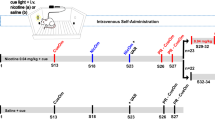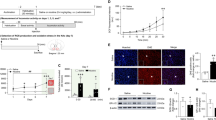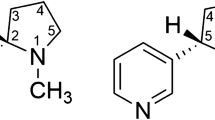Abstract
Stimulant drugs, including D-amphetamine, cocaine, and methylphenidate, increase cigarette smoking in controlled human laboratory experiments. Although the mechanism(s) underlying this effect are unknown, it is possible that stimulants may enhance directly the abuse-related effects of nicotine. In the present study, we characterized the behavioral pharmacological interactions between methylphenidate and nicotine in the intravenous self-administration, drug discrimination, and locomotor cross-sensitization procedures. Adult male Sprague–Dawley rats were trained to respond for intravenous nicotine (0.01 or 0.03 mg/kg/infusion) or sucrose, and the acute effects of methylphenidate (1.25–10 mg/kg) were determined; in addition, separate groups of rats were treated with methylphenidate (2.5 mg/kg) or saline before 12 consecutive nicotine (0.03 mg/kg/infusion) self-administration sessions. Next, the discriminative stimulus effects of nicotine (0.03–0.3 mg/kg) and methylphenidate (1.25–10 mg/kg), alone and in combination with a low nicotine dose (0.056 mg/kg), were tested in nicotine-trained rats. Finally, the locomotor effect of repeated methylphenidate (2.5 mg/kg) was tested in rats previously treated with nicotine (0.2–0.8 mg/kg). Results indicated that acute methylphenidate increased the rate of nicotine self-administration at doses that reduced sucrose-maintained responding; furthermore, tolerance to this effect was not apparent following repeated methylphenidate. Methylphenidate, while not substituting for nicotine alone, dose-dependently enhanced the discriminative stimulus effect of a low nicotine dose. In addition, repeated nicotine exposure promoted the development of locomotor sensitization to methylphenidate. Taken together with recent clinical findings, these results suggest that methylphenidate may enhance the abuse-related behavioral effects of nicotine, perhaps increasing vulnerability to tobacco dependence.
Similar content being viewed by others
Log in or create a free account to read this content
Gain free access to this article, as well as selected content from this journal and more on nature.com
or
References
Andersen SL (2005). Stimulants and the developing brain. Trends Pharmacol Sci 26: 237–243.
Andersen SL, Arvanitogiannis A, Pliakas AM, LeBlanc C, Carlezon Jr WA (2002). Altered responsiveness to cocaine in rats exposed to methylphenidate during development. Nat Neurosci 5: 13–14.
Arnold JM, Roberts DC (1997). A critique of fixed and progressive ratio schedules used to examine the neural substrates of drug reinforcement. Pharmacol Biochem Behav 57: 441–447.
Arnsten AF (2006). Stimulants: therapeutic actions in ADHD. Neuropsychopharmacology 31: 2376–2383.
Bardo MT (1998). Neuropharmacological mechanisms of drug reward: beyond dopamine in the nucleus accumbens. Crit Rev Neurobiol 12: 37–67.
Bardo MT, Bevins RA, Klebaur JE, Crooks PA, Dwoskin LP (1997). (−)-Nornicotine partially substitutes for (+)-amphetamine in a drug discrimination paradigm in rats. Pharmacol Biochem Behav 58: 1083–1087.
Bardo MT, Green TA, Crooks PA, Dwoskin LP (1999). Nornicotine is self-administered intravenously by rats. Psychopharmacology 146: 290–296.
Barkley RA, Fischer M, Edelbrock CS, Smallish L (1990). The adolescent outcome of hyperactive children diagnosed by research criteria: I. An 8-year prospective follow-up study. J Am Acad Child Adolesc Psychiatry 29: 546–557.
Benwell ME, Balfour DJ (1992). The effects of acute and repeated nicotine treatment on nucleus accumbens dopamine and locomotor activity. Br J Pharmacol 105: 849–856.
Biederman J, Spencer T, Wilens T (2004). Evidence-based pharmacotherapy for attention-deficit hyperactivity disorder. Int J Neuropsychopharmacol 7: 77–97.
Birrell CE, Balfour DJ (1998). The influence of nicotine pretreatment on mesoaccumbens dopamine overflow and locomotor responses to D-amphetamine. Psychopharmacology 140: 142–149.
Brandon CL, Marinelli M, Baker LK, White FJ (2001). Enhanced reactivity and vulnerability to cocaine following methylphenidate treatment in adolescent rats. Neuropsychopharmacology 25: 651–661.
Brioni JD, Kim DJ, O'Neill AB, Williams JE, Decker MW (1994). Clozapine attenuates the discriminative stimulus properties of (−)-nicotine. Brain Res 643: 1–9.
Caggiula AR, Donny EC, White AR, Chaudhri N, Booth S, Gharib MA et al (2001). Cue dependency of nicotine self-administration and smoking. Pharmacol Biochem Behav 70: 515–530.
Caggiula AR, Donny EC, White AR, Chaudhri N, Booth S, Gharib MA et al (2002). Environmental stimuli promote the acquisition of nicotine self-administration in rats. Psychopharmacology 163: 230–237.
Carlezon Jr WA, Mague SD, Andersen SL (2003). Enduring behavioral effects of early exposure to methylphenidate in rats. Biol Psychiatry 54: 1330–1337.
Collins SL, Izenwasser S (2004). Chronic nicotine differentially alters cocaine-induced locomotor activity in adolescent vs adult male and female rats. Neuropharmacology 46: 349–362.
Connors CK, Levin ED, Sparrow E, Hinton SC, Erhardt D, Meck WH et al (1996). Nicotine and attention in adult attention deficit hyperactivity disorder (ADHD). Psychopharmacol Bull 32: 67–73.
Corrigall WA, Coen KM (1989). Nicotine maintains robust self-administration in rats on a limited-access schedule. Psychopharmacology 99: 473–478.
Corrigall WA, Coen KM (1991). Selective dopamine antagonists reduce nicotine self-administration. Psychopharmacology 104: 171–176.
Corrigall WA, Coen KM (1994). Dopamine mechanisms play at best a small role in the nicotine discriminative stimulus. Pharmacol Biochem Behav 48: 817–820.
Corrigall WA, Franklin KB, Coen KM, Clarke PB (1992). The mesolimbic dopaminergic system is implicated in the reinforcing effects of nicotine. Psychopharmacology 107: 285–289.
Cousins MS, Stamat HM, de Wit H (2001). Acute doses of d-amphetamine and bupropion increase cigarette smoking. Psychopharmacology 157: 243–253.
Desai RI, Barber DJ, Terry P (1999). Asymmetric generalization between the discriminative stimulus effects of nicotine and cocaine. Behav Pharmacol 10: 647–656.
Desai RI, Barber DJ, Terry P (2003). Dopaminergic and cholinergic involvement in the discriminative stimulus effects of nicotine and cocaine in rats. Psychopharmacology 167: 335–343.
Dwoskin LP, Crooks PA, Teng L, Green TA, Bardo MT (1999). Acute and chronic effects of nornicotine on locomotor activity in rats: altered response to nicotine. Psychopharmacology 145: 442–451.
Dwoskin LP, Rauhut AS, King-Pospisil KA, Bardo MT (2006). Review of the pharmacology and clinical profile of bupropion, an antidepressant and tobacco use cessation agent. CNS Drug Rev 12: 178–207.
Fattore L, Cossu G, Martellotta MC, Fratta W (2002). Baclofen antagonizes intravenous self-administration of nicotine in mice and rats. Alcohol Alcohol 5: 495–498.
Files FJ, Branch MN, Clody D (1989). Effects of methylphenidate on responding under extinction in the presence and absence of conditioned reinforcement. Behav Pharmacol 1: 113–121.
Fowler JS, Logan J, Wang GJ, Volkow ND (2003). Monoamine oxidase and cigarette smoking. Neurotoxicology 24: 75–82.
Gasior M, Jaszyna M, Munzar P, Witkin JM, Goldberg SR (2002). Caffeine potentiates the discriminative-stimulus effects of nicotine in rats. Psychopharmacology 162: 385–395.
Gerasimov MR, Franceschi M, Volkow ND, Gifford A, Gatley SJ, Marsteller D et al (2000a). Comparison between intraperitoneal and oral methylphenidate administration: a microdialysis and locomotor study. J Pharmacol Exp Ther 295: 51–57.
Gerasimov MR, Franceschi M, Volkow ND, Rice O, Schiffer WK, Dewey SL (2000b). Synergistic interactions between nicotine and cocaine or methylphenidate depend on the dose of dopamine transporter inhibitor. Synapse 38: 432–437.
Grace AA (2001). Psychostimulant actions on dopamine and limbic system function: relevance to the pathophysiology and treatment of ADHD. In: Solanto MV, Arnsten AFT, Castellanos FX (eds). Stimulant Drugs and ADHD: Basic and Clinical Neuroscience. University Press: Oxford, pp 134–157.
Greenhill LL (2001). Clinical effects of stimulant medication in ADHD. In: Solanto MV, Arnsten AFT, Castellanos FX (eds). Stimulant Drugs and ADHD: Basic and Clinical Neuroscience. University Press: Oxford, pp 31–72.
Guillem K, Vouillac C, Azar MR, Parsons LH, Koob GF, Cador M et al (2005). Monoamine oxidase inhibition dramatically increases the motivation to self-administer nicotine in rats. J Neurosci 25: 8593–8600.
Guillem K, Vouillac C, Azar MR, Parsons LH, Koob GF, Cador M et al (2006). Monoamine oxidase A rather than monoamine oxidase B inhibition increases nicotine reinforcement in rats. Eur J Neurosci 24: 3532–3540.
Han DD, Gu HH (2006). Comparison of the monoamine transporters from human and mouse in their sensitivities to psychostimulant drugs. BMC Pharmacol 6: 6.
Harrod SB, Mactutus CF, Bennett K, Hasselrot U, Wu G, Welch M et al (2004). Sex differences and repeated intravenous nicotine: behavioral sensitization and dopamine receptors. Pharmacol Biochem Behav 78: 581–592.
Henningfield JE, Griffiths RR (1981). Cigarette smoking and subjective response: effects of d-amphetamine. Clin Pharmacol Ther 30: 497–505.
Kollins SH, McClernon FJ, Fuemmeler BF (2005). Association between smoking and attention-deficit/hyperactivity disorder symptoms in a population-based sample of young adults. Arch Gen Psychiatry 62: 1142–1147.
Kuczenski R, Segal DS (2005). Stimulant actions in rodents: implications for attention-deficit/hyperactivity disorder treatment and potential stimulant abuse. Biol Psychiatry 57: 1391–1396.
Kuribara H (1999). Does nicotine modify the psychotoxic effect of methamphetamine? Assessment in terms of locomotor sensitization in mice. J Toxicol Sci 24: 55–62.
Lambert NM, Hartsough CS (1998). Prospective study of tobacco smoking and substance dependencies among samples of ADHD and non-ADHD participants. J Learn Disabil 31: 533–544.
Le Foll B, Sokoloff P, Stark H, Goldberg SR (2005). Dopamine D3 receptor ligands block nicotine-induced conditioned place preferences through a mechanism that does not involve discriminative-stimulus or antidepressant-like effects. Neuropsychopharmacology 30: 720–730.
LeSage MG, Gustaf E, Dufek MB, Pentel PR (2006). Effects of maternal intravenous nicotine administration on locomotor behavior in pre-weanling rats. Pharmacol Biochem Behav 85: 575–583.
Leshner AI, Koob GF (1999). Drugs of abuse and the brain. Proc Assoc Am Physicians 111: 99–108.
Levin ED, Connors CK, Silva D, Canu W, March J (2001). Effects of chronic nicotine and methylphenidate in adults with attention deficit/hyperactivity disorder. Exp Clin Psychopharmacol 9: 83–90.
Mansbach RS, Rovetti CC, Freedland CS (1998). The role of monoamine neurotransmitter systems in the nicotine discriminative stimulus. Drug Alcohol Depend 52: 125–134.
Mansvelder HD, De Rover M, McGehee DS, Brussaard AB (2003). Cholinergic modulation of dopaminergic reward areas: upstream and downstream targets of nicotine addiction. Eur J Pharmacol 480: 117–123.
Mansvelder HD, McGehee DS (2002). Cellular and synaptic mechanisms of nicotine addiction. J Neurobiol 53: 606–617.
Middleton LS, Cass WA, Dwoskin LP (2004). Nicotinic receptor modulation of dopamine transporter function in rat striatum and medial prefrontal cortex. J Pharmacol Exp Ther 308: 367–377.
Palmatier MI, Evans-Martin FF, Hoffman A, Caggiula AR, Chaudhri N, Donny EC et al (2006). Dissociating the primary reinforcing and reinforcement-enhancing effects of nicotine using a rat self-administration paradigm with concurrently available drug and environmental reinforcers. Psychopharmacology 184: 391–400.
Paterson NE, Semenova S, Gasparini F, Markou A (2003). The mGluR5 antagonist MPEP decreased nicotine self-administration in rats and mice. Psychopharmacology 167: 257–264.
Pierce RC, Kalivas PW (1997). A circuitry model of the expression of behavioral sensitization to amphetamine-like psychostimulants. Brain Res Brain Res Rev 25: 192–216.
Pontieri FE, Tanda G, Orzi F, Di Chiara G (1996). Effects of nicotine on the nucleus accumbens and similarity to those of addictive drugs. Nature 382: 255–257.
Potter AS, Newhouse PA (2004). Effects of acute nicotine administration on behavioral inhibition in adolescents with attention-deficit/hyperactivity disorder. Psychopharmacology 176: 182–194.
Prada JA, Goldberg SR (1985). Effects of caffeine or nicotine pretreatments on nicotine self-administration by the squirrel monkey. Pharmacologist 27: 226.
Rauhut AS, Dwoskin LP, Bardo MT (2005). Tolerance does not develop to the decrease in nicotine self-administration produced by repeated bupropion administration. Nicotine Tob Res 7: 901–907.
Rauhut AS, Mullins SN, Dwoskin LP, Bardo MT (2002). Reboxetine: attenuation of nicotine self-administration in rats. J Pharm Exp Ther 303: 664–672.
Rauhut AS, Neugebauer N, Dwoskin LP, Bardo MT (2003). Effect of bupropion on nicotine self-administration in rats. Psychopharmacology 169: 1–9.
Richardson NR, Roberts DC (1996). Progressive ratio schedules in drug self-administration studies in rats: a method to evaluate reinforcing efficacy. J Neurosci Methods 66: 1–11.
Robbins TW (1978). The acquisition of responding with conditioned reinforcement: effects of pipradrol, methylphenidate, d-amphetamine and nomifensine. Psychopharmacology 58: 79–87.
Rohde P, Kahler CW, Lewinsohn PM, Brown RA (2004). Psychiatric disorders, familial factors, and cigarette smoking: III. Associations with cessation by young adulthood among daily smokers. Nicotine Tob Res 6: 509–522.
Rose JE, Levin ED (1991). Inter-relationships between conditioned and primary reinforcement in the maintenance of cigarette smoking. Br J Addict 86: 605–609.
Roll JM, Higgins ST, Tidey J (1997). Cocaine use can increase cigarette smoking: evidence from laboratory and naturalistic settings. Exp Clin Psychopharmacol 5: 263–268.
Rush CR, Higgins ST, Vansickel AR, Stoops WW, Lile JA, Glaser PE (2005). Methylphenidate increases cigarette smoking. Psychopharmacology 181: 781–789.
Schorling JB, Gutgesell M, Klas P, Smith D, Keller A (1994). Tobacco, alcohol and other drug use among college students. J Subst Abuse 6: 105–115.
Shoaib M, Sidhpura N, Shafait S (2003). Investigating the actions of bupropion on dependence-related effects of nicotine in rats. Psychopharmacology 165: 405–412.
Sigmon SC, Tidey JW, Badger GJ, Higgins ST (2003). Acute effects of D-amphetamine on progressive-ratio performance maintained by cigarette smoking and money. Psychopharmacology 167: 393–402.
Solanto MV, Arnsten AFT, Castellanos FX (2001). Stimulant Drugs and ADHD: Basic and Clinical Neuroscience. University Press: Oxford, pp 134–157.
Tidey JW, O'Neill SC, Higgins ST (2000). D-Amphetamine increases choice of cigarette smoking over monetary reinforcement. Psychopharmacology 153: 85–92.
Torres-Reveron A, Dow-Edwards DL (2005). Repeated administration of methylphenidate in young, adolescent, and mature rats affects the response to cocaine later in adulthood. Psychopharmacology 181: 38–47.
Tzavara ET, Bymaster FP, Overshiner CD, Davis RJ, Perry KW, Wolff M et al (2006). Procholinergic and memory enhancing properties of the selective norepinephrine uptake inhibitor atomoxetine. Mol Psychiatry 11: 187–195.
Vezina P (2004). Sensitization of midbrain dopamine neuron reactivity and the self-administration of psychomotor stimulant drugs. Neurosci Biobehav Rev 27: 827–839.
Volkow ND, Swanson JM (2003). Variables that affect the clinical use and abuse of methylphenidate in the treatment of ADHD. Am J Psychiatry 160: 1909–1918.
Volkow ND, Wang GJ, Fowler JS, Ding YS (2005). Imaging the effects of methylphenidate on brain dopamine: new model on its therapeutic actions for attention-deficit/hyperactivity disorder. Biol Psychiatry 57: 1410–1415.
Watkins SS, Epping-Jordan MP, Koob GF, Markou A (1999). Blockade of nicotine self-administration with nicotinic antagonists in rats. Pharmacol Biochem Behav 62: 743–751.
Wiley JL, Lavecchia KL, Martin BR, Damaj MI (2002). Nicotine-like discriminative stimulus effects of bupropion in rats. Exp Clin Psychopharmacol 10: 129–135.
Wilkinson JL, Palmatier MI, Bevins RA (2006). Preexposure to nicotine alters the subsequent locomotor stimulant effects of bupropion in rats. Nicotine Tob Res 8: 141–146.
Wise RA (1998). Drug-activation of brain reward pathways. Drug Alcohol Depend 51: 13–22.
Wooters TE, Dwoskin LP, Bardo MT (2006). Age and sex differences in the locomotor effect of repeated methylphenidate in rats classified as high or low novelty responders. Psychopharmacology 188: 18–27.
Yokel RA (1987). Intravenous self-administration: response rates, the effects of pharmacological challenges, and drug preferences. In: Bozarth MA (ed). Methods of Assessing the Reinforcing Properties of Abused Drugs. Springer-Verlag: New York, pp 1–33.
Young R, Glennon RA (2002). Nicotine and bupropion share a similar discriminative stimulus effect. Eur J Pharmacol 443: 113–118.
Acknowledgements
We acknowledge the technical assistance provided by Joshua Cutshall, Laura Fenton, and Emily Geary. We also thank Dr Drake Morgan for helpful suggestions regarding the drug discrimination training procedure. During preparation of the manuscript, TE Wooters was supported by NIDA Predoctoral Training Grant T32 DA007304 and NM Neugebauer was supported by NIDA Predoctoral Training Grant T32 DA016176. Funding was provided by NIH Grant DA 017548.
Author information
Authors and Affiliations
Corresponding author
Additional information
DISCLOSURE/CONFLICT OF INTEREST
The authors do not have any conflict of interests (financial or otherwise) that might bias this work.
Rights and permissions
About this article
Cite this article
Wooters, T., Neugebauer, N., Rush, C. et al. Methylphenidate Enhances the Abuse-Related Behavioral Effects of Nicotine in Rats: Intravenous Self-Administration, Drug Discrimination, and Locomotor Cross-Sensitization. Neuropsychopharmacol 33, 1137–1148 (2008). https://doi.org/10.1038/sj.npp.1301477
Received:
Revised:
Accepted:
Published:
Issue date:
DOI: https://doi.org/10.1038/sj.npp.1301477
Keywords
This article is cited by
-
Nicotine drug discrimination and nicotinic acetylcholine receptors in differentially reared rats
Psychopharmacology (2018)
-
κ-Opioid System Regulates the Long-Lasting Behavioral Adaptations Induced by Early-Life Exposure to Methylphenidate
Neuropsychopharmacology (2009)
-
Nicotinic receptors differentially modulate the induction and expression of behavioral sensitization to methylphenidate in rats
Psychopharmacology (2009)
-
Nicotine and amphetamine acutely cross-potentiate their behavioral and neurochemical responses in female Holtzman rats
Psychopharmacology (2008)
-
A pharmacological analysis of stimulant-induced increases in smoking
Psychopharmacology (2007)



